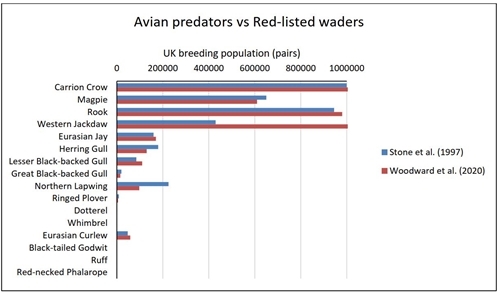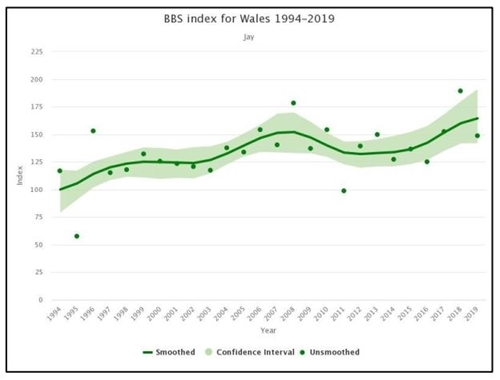As highlighted here, NRW are considering the future of some General Licences in Wales. We wanted to make our submission publicly available.
Dear NRW Board Member,
In preparation for your board meeting on the 24th of March 2022, the Game and Wildlife Conservation Trust (GWCT) wishes to highlight key points for Agenda Item 13 - Review of NRW’s Approach to Regulating the Shooting and Trapping of Wild Birds: General Licences; where you are being asked to approve the approach to granting general licences (Paper ref: 22-03-B15).
There are several proposed changes which we think would be seriously detrimental to the conservation and recovery of wild birds in Wales. As such we wish to draw your attention to them and explain our concerns in the hope that you may question and reject the proposed approach.
As a point of clarity, the GWCT is an independent research & education charity (not a pro-shooting organisation) but our evidence does show that best practice game management practices can produce a net gain to biodiversity and enhance the British Countryside. We employ 57 applied scientists. We use and apply science to solve problems and produce positive game and wildlife outcomes. For example, with a declining species, we accurately identify the causes of decline, research potential solutions to them and if they are successful, package them up into management options that work for the land use community. In the English Environmental Stewardship Scheme (ELS & HLS), of the 37 management options available to farmers, seven were invented by the GWCT and a further 23 had a research input from us. We include this information to demonstrate the breadth of our research and highlight that first and foremost we aim to conserve and enhance biodiversity.
We believe that predation control can play a crucial role in modern conservation, and as such our peer-reviewed science has been the catalyst for many organisations undertaking predation control for species recovery. Furthermore, Defra has stated it is fully aligned with our proposals for predation control to form part of species recovery within the Local Nature Recovery scheme within the Environmental Land Management schemes (ELMs); and to that end the Land Management Reform Team of Welsh Government is interested in the role of predation control as an important tool for species recovery within the Sustainable Farming Scheme in Wales.
Welsh Government has rightly declared a Nature Emergency; and the decline of our farmland birds has been catastrophic, with no respite despite much public funding to improve habitat across Wales. GWCT has demonstrated the important role predation control can play in successfully reversing these farmland bird declines, when deployed alongside the provision of good habitat. The control of magpie and jay can play an important role in reducing predation pressure which can otherwise supress the recovery of many hedgerow and woodland nesting farmland birds. NRW staff have reviewed the scientific literature and summarised ‘there is a medium-high strength of evidence of some likelihood of a high effect of predation by magpie and jay on populations of wild birds’. This conclusion is aligned with the APHA 2020 report for Defra and by Newson et al. 2019 for NatureScot.
We are therefore very concerned that NRW propose to remove magpie, jay and jackdaw from General Licence 004 - Licence to kill or take certain wild birds for the purpose of conserving certain wild birds. Rather than encouraging conservation measures which are proven to work, NRW are instead proposing to severely restrict conservationists’ ability to recover farmland bird populations.
To address magpie first: we are fully aware that magpies have declined by 43% in Wales between 1995 -2018 and on current trajectory could become Amber listed under the Birds of Conservation Concern (BoCC) criteria applied to Wales.
Within the review, NRW propose to adopt a set of principles which must all be satisfied before considering it appropriate to allow the control of a species under a general licence. Principle 5 states that NRW only consider it suitable to include species that are not red, or amber listed using the BoCC criteria. Whilst we fully support the BoCC assessment as a crucial aid in identifying species and habitat conservation priorities (our Deputy Director of Research Dr Nicholas Aebischer Lic ès Sc Math, PhD is a co author), we do not believe that NRW is correct to use it as outlined in Principle 5 because, in the proposed context it fails to recognise and contextualise historic population increases. Between the 1960s and 1990s the magpie population at least doubled in the UK (there are no equivalent Wales-only data for that time). See figure 1 below.

Figure 1: Magpie: Smoothed population index (with 85% confidence limits in green) for Magpie in the UK 1966 -2017 (BTO/JNCC/RSPB Breeding Bird Survey BBS and Common Bird Census CBC) Woodward et al. 2019 https://app.bto.org/birdtrends/species.jsp?s=magpi&year=2018
Since 1995 the Welsh population has declined (see Figure 2), but in the context of the historical increase magpie are still abundant in Wales. Generally speaking, using BoCC Amber listing as an argument for decision-making is inappropriate because the Amber-listing criteria are so varied; for instance, European or UK importance is sufficient to place a species on the Welsh Amber list. The BoCC criteria is not a measure of absolute population size and neither does it compare predator and associated prey populations.We would therefore argue that a better ‘measuring stick’ for a species inclusion on a general licence would be a comparison of the IUCN’s ‘risk of extinction’ categorisation for predators and their associated prey populations.

Figure 2: Magpie: Smoothed population index (with 85% confidence limits in green) for Magpie in Wales 1994 -2019 (BTO/JNCC/RSPB Breeding Bird Survey BBS) https://www.bto.org/our-science/projects/bbs/latest-results/trend-graphs
We base this recommendation on the precautionary principle: prey species that are nearer to extinction than associated predators should be given a greater level of protection than those predators, even though populations of both species may be declining. To illustrate, below, we present data on the changes in population sizes of breeding ground-nesting waders in the UK compared with those of avian nest predators including gulls (but excluding raptors). The combined ‘weight’ of avian nest predator populations is many times greater than that of the waders. See Figure 3.

Figure 3: Comparison of how UK breeding population sizes have changed over 25 years for avian predators vs Red-listed waders
Within the review, NRW states that breeding population sizes for the majority of species listed on general licences have been relatively stable or increasing significantly. We would further highlight that there is no evidence that a species’ inclusion on a general licence is detrimental to the population of that species. In particular, the magpie has been a controllable species under the general licences since (and prior to) their inception i.e. during the historic increases seen in Figure 1. We can therefore have a high degree of confidence that ‘allowing the lethal control of a species under a general licence does not jeopardise its conservation status’ which is key to NRW proposing Principle 5 in the first place.
Given the high degree of confidence that lethal control does not jeopardise a species’ conservation status, a halfway house could have been a Class Licence, where registered users would need to report cull numbers back to NRW. This would allow NRW to monitor the situation as desired whilst also not risking the conservation status of prey species. This would be a much better alternative to a Specific Licence which requires much greater resource from NRW, takes 30 days to produce and can require an unobtainable level of evidence to acquire.
Regrading NRW’s proposal for jackdaw: we are aware there is less evidence available for jackdaw, with NRW, the APHA report and Newson et al. 2019 summarising ‘there is medium-low strength of evidence for an impact of jackdaw on the conservation of wild birds. However, we highlight that absence of evidence is not evidence of absence, and it is almost impossible to obtain data highlighting the impact of one species in predator removal studies. Anecdotal evidence from practitioner responses to GWCT surveys at the UK level provides evidence that jackdaw predate the eggs and chicks of wild birds including species such as curlew and lapwing. Given that the jackdaw population is stable in Wales (see Figure 4), we would prefer to see the precautionary principle applied to provide protection to those species that the IUCN categorises ‘at risk of extinction’ as argued above.

Figure 4: Jackdaw: Smoothed population index (with 85% confidence limits in green) for Jackdaw in Wales 1994 -2019 (BTO/JNCC/RSPB Breeding Bird Survey BBS) https://www.bto.org/our science/projects/bbs/latest-results/trend-graphs
To address NRW’s proposal for jay: within the review and based on the evidence NRW states ‘we believe that it is appropriate to include jay on a general licence for the purpose of conserving wild birds, but that the beneficiary species of such control should be restricted to breeding wild bird species of scrub and woodland habitats’. Indeed, this has been the process followed in England. We would highlight that jay numbers are increasing in Wales (see Figure 5), yet despite this and NRW’s own beliefs, it is now proposing to remove jay from the general licence.

Figure 5: Jay: Smoothed population index (with 85% confidence limits in green) for Jay in Wales 1994 -2019 (BTO/JNCC/RSPB Breeding Bird Survey BBS) https://www.bto.org/our-science/projects/bbs/latest-results/trend-graphs
Although the scientific evidence in the review would seem to be in favour of including jay on GL 004, the public consultation response is seemingly the only reason why NRW are now proposing to remove jay from the licence; with 82% of responses disagreeing that jay should be included on a general licence. Predation control is a complex and emotive topic, and we firmly believe that following the science and being evidence-led is the correct way to make decisions on the topic. The decisions need to be right for conservation and biodiversity in Wales. To further this example, 72% of responses also thought that carrion crow should be removed from GL004; we wonder where that would leave our red-listed and Endangered curlew in Wales?
Yours sincerely,
Matthew Goodall BSc, MSc
Head of Education and Advisor Wales
Phone: 07741 902021
Email: mgoodall@gwct.org.uk